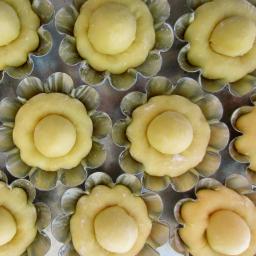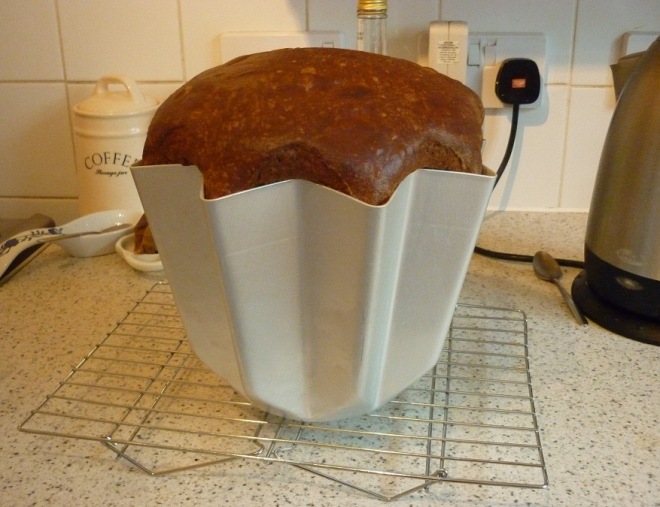Last night brought the fourth in this series of attempts to bake a proper loaf of this wonderful tasting bread. In short, this bake offered only incremental improvement over previous efforts, but the essential problem still remains unresolved. In this bake one of the two loaves promptly caved in upon removal from the baking pans for cooling. This happened within 60 to 90 seconds of removing the loaves from the pan. It happens quickly enough that you can watch the sides pull in. In this bake, however, only one of the loaves did this. That might be progress.
The changes for this bake were as follows:
1) No malt at all this time. I dropped the malt because I do not have non-diastatic malt on hand, although it is required by the formula. There is considerable discussion of the topic of malt in the posts on my prior bakes if you want to catch up there.
2) King Arthur All Purpose flour (11.7% protein) I concluded, correctly I think, that this is not a flour issue but I made the change to clear up a troubleshooting checklist item. Other bakers (see previous posts) have produced excellent loaves of this bread with other flours.
3) More careful attention to tracking dough temperature. The initial target dough temperature of 78F was achieved after combining all the ingredients in the initial mix. I was surprised at the "friction factor" input by my Bosch mixer though, and ended up with a final dough temperature going into bulk fermentation of 91F. With a 14 1/2 minute mix that's almost a degree per minute. It ended up much higher than I expected, and proves I do not use my mixer very often. If I did I'd have been more aware of this beforehand. In the end I don't think it mattered.
4) A thorough degassing of the dough by hand kneading several strokes on an unfloured board after 40 minutes of bulk fermenation that doubled the dough. The dough doubled again compared to the initial post-mix volume in another 35 minutes.
5) Aggressive degassing prior to shaping, and shaped by tightly rolling up the dough and sealing only the bottom seam, tightly.
6) I preheated my oven for 45 minutes at 375F prior to loading, and reduced to 350F immediately upon loading. I also verified my oven temperature as accurate prior to loading. My oven holds the temperature set on the control panel.
Observations:
The first and biggest point that I noticed, when rounding for the bulk rise, was that this dough seemed drier and stiffer than in previous bakes. I wished I had added more water to loosen it up, but it was, I thought, too late by then. This was even more apparent at the degassing during bulk, and I really paid for it in trying to shape the dough.
Shaping, especially trying to pre-form the dough into the requisite rectangles prior to rolling up, was made difficult by the lack of extensibility in this dough. It was very like working with a big, heavy rubber band. I could stretch it out, with difficulty, but it would pull back immediately if I let go. It was very difficult to pre-shape, even after a 30 minute rest after dividing. (Is this a result of holding out the malt, even the wrong type?) Due to the dryness of the dough it was also difficult to seal the seams. After finally getting the bottom seams to seal I elected to just leave the ends open. I really missed the silky suppleness of this dough in previous bakes.
Final proofing took longer, as I expected, due I'm certain to the degassing and second bulk rise. Instead of taking 45-60 minutes, these were not ready to bake until 75-80 minutes after shaping. I proofed these on a bookshelf waist high and a few feet from the wood stove. The thermometer on that shelf read 75F for the entire time period (good wood stove!). This is the same place I proofed attempt #3 the previous evening.
Here is the pictorial record:
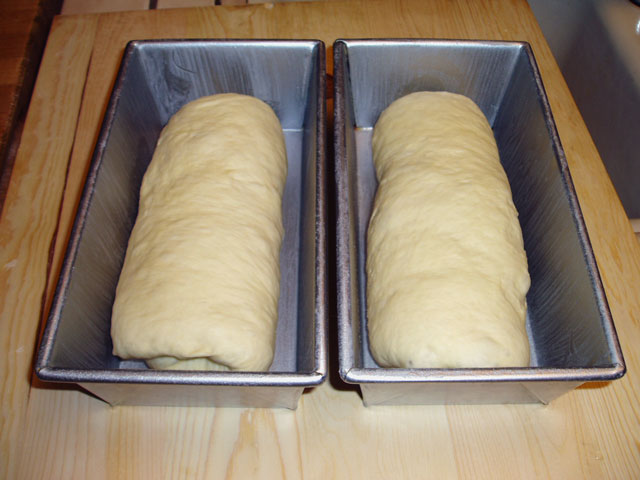
Shaped, panned and ready for final proof.
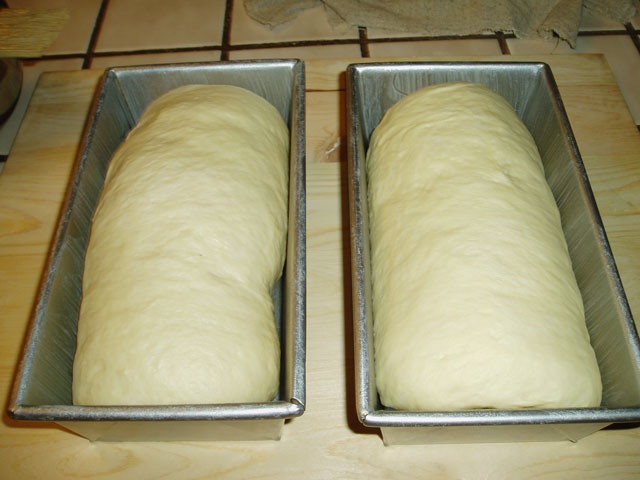
Proofed and ready for the egg wash and slash.
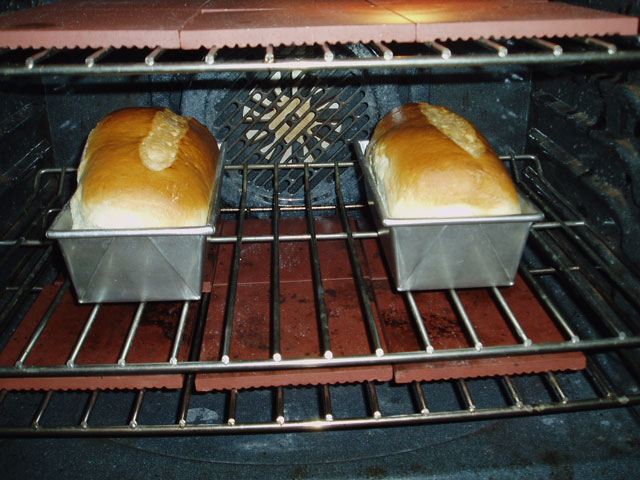
This shows the relative positions in the oven, and the uneven spring/shape and orientation.
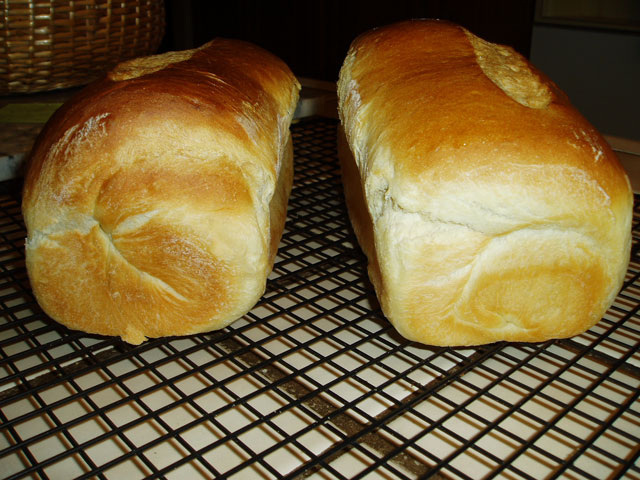
Finished loaves.
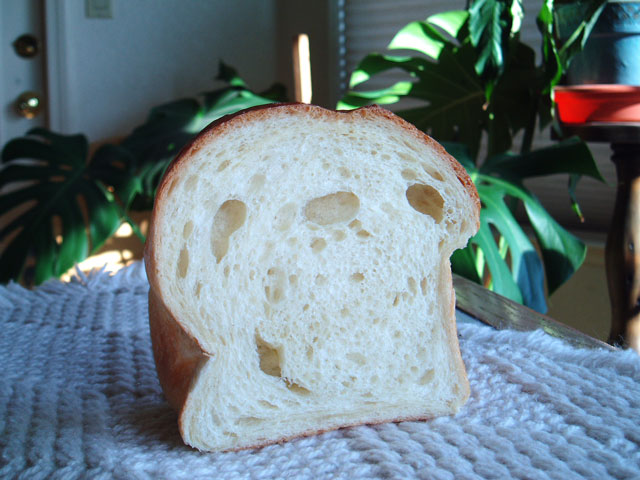
The cross-section shows some much larger holes in the crumb than were present in previous bakes. It also makes clear that the sides of this loaf caved in, one more than the other, once again. This cave in only happened on one of the two loaves though. This shot does not show it, but this loaf also had some side-wall compression expressed in a doughy strip just inside the crust, but not as much as previous bakes. The other loaf looks quite nice, and I will gift it to a neighbor. We have plenty, trust me.
So, some forward progress is made, but not a lot. The dough did not seem dry during the mix as I checked the gluten development, but it certainly was apparent when I tried to round the dough for bulk fermentation. I am unsure about why this dough was so elastic. I think that if I can resolve those issues I can do a better job of shaping and so better control the spring of the loaf. The degassing and second rise in bulk fermentation seems to have controlled the oven spring. I think this bake produced far more normal spring in the oven than any of my previous attempts. Thanks go to MiniOven and Andy for that!
I will bake this yet again, but not until next week. I have other commitments for the next few evenings, and I need a break too. Perhaps just some time to reflect and back up out of the leaves will give me a more productive view of the forest on this one. I think I will bake some sourdough this weekend, just to do something different as well.
Thanks for stopping by!
OldWoodenSpoon














